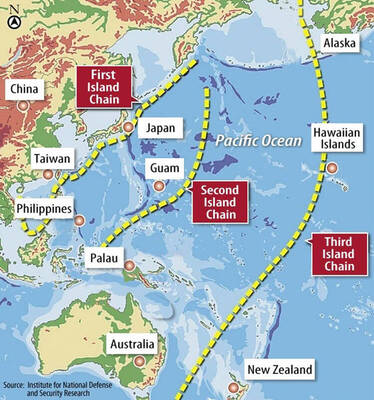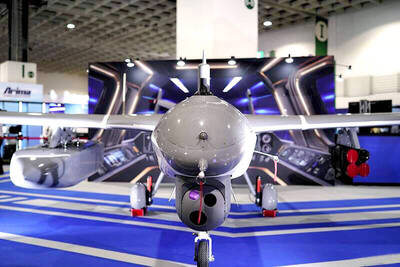A Chinese Nationalist Party (KMT) task force on cross-strait discourse has proposed new guidelines for the construction of stable and peaceful relations across the Taiwan Strait as part of the party’s reform efforts.
The task force, overseen by the KMT’s reform committee, proposed four pillars for the party’s handling of cross-strait relations at yesterday’s meeting of the committee: upholding the Republic of China’s national sovereignty; safeguarding freedom, democracy and human rights; prioritizing the safety of Taiwan; and creating win-win cross-strait relations.
In its presentation, the task force proposed that the “1992 consensus” should be viewed as “a historical description of past cross-strait interaction.”

Photo: Chien Jung-fong, Taipei Times
The so-called “1992 consensus” — a term that former Mainland Affairs Council chairman Su Chi (蘇起) in 2006 admitted making up in 2000 — refers to a tacit understanding between the KMT and the Chinese Communist Party (CCP) that both sides acknowledge that there is “one China,” with each side having its own interpretation of what “China” means.
Although past KMT administrations had deemed the “1992 consensus” an important basis for seeking common ground in cross-strait interaction, the term has been marred by President Tsai Ing-wen’s (蔡英文) administration, the task force said.
Chinese President Xi Jinping’s (習近平) speech last year marking the anniversary of the 1979 “message to compatriots in Taiwan” also generated strong opposition to the term among Taiwanese, as Xi urged them to accept Beijing’s “one country, two systems” formula based on his claim that it was part of the “1992 consensus,” it added.
Tensions across the Taiwan Strait have not been higher since Beijing launched missile tests in 1996, as it attempted to influence Taiwan’s first direct presidential election that year, it said.
The task force recommended that the KMT, as a party with a strong sense of responsibility, use the guidelines to work toward stable cross-strait relations, saying that it should push for a legal mechanism with oversight powers that would allow cross-strait negotiations to be as open and transparent as possible.
Legislation should be drafted to regulate interaction between officials across the Strait so that exchanges based on inappropriate interests end, it said.
The KMT would continue to promote long-term economic and trade relations across the Strait, but would ensure that the fruits of such economic development benefit the majority of Taiwanese, the task force said.
“We will do everything we can for peace, but we will never kneel down for it,” the task force said. “The KMT will never accept any option that alters the national sovereignty of the Republic of China — therefore ‘one country, two systems’ is not an option for Taiwanese.”
“We also know that Taiwanese independence is unfeasible. Cutting off Zhonghua (中華) symbols and slashing the inheritance of the minkuo (民國) would not only create rifts in Taiwanese society, but also block the support that it receives from the international community, which it needs very much,” it added.
The four guidelines are the keys to resolving long-time opposition between Taiwan and China, it said.
Following the presentation, KMT Chairman Johnny Chiang (江啟臣) said that the “change toward the ‘1992 consensus’ was not introduced by the KMT, but by Beijing and the Democratic Progressive Party (DPP), who have led the Taiwanese public to misunderstand and distrust the term.”
KMT members should be open-minded toward the variety of political views held by different generations of Taiwanese, he added.
Like the DPP, the KMT stands for national sovereignty, democracy and human rights, Chiang said, adding that he hopes the four guidelines can take the party to a better place on its way to reform.

The US government has signed defense cooperation agreements with Japan and the Philippines to boost the deterrence capabilities of countries in the first island chain, a report by the National Security Bureau (NSB) showed. The main countries on the first island chain include the two nations and Taiwan. The bureau is to present the report at a meeting of the legislature’s Foreign Affairs and National Defense Committee tomorrow. The US military has deployed Typhon missile systems to Japan’s Yamaguchi Prefecture and Zambales province in the Philippines during their joint military exercises. It has also installed NMESIS anti-ship systems in Japan’s Okinawa

‘WIN-WIN’: The Philippines, and central and eastern European countries are important potential drone cooperation partners, Minister of Foreign Affairs Lin Chia-lung said Minister of Foreign Affairs Lin Chia-lung (林佳龍) in an interview published yesterday confirmed that there are joint ventures between Taiwan and Poland in the drone industry. Lin made the remark in an exclusive interview with the Chinese-language Liberty Times (the Taipei Times’ sister paper). The government-backed Taiwan Excellence Drone International Business Opportunities Alliance and the Polish Chamber of Unmanned Systems on Wednesday last week signed a memorandum of understanding in Poland to develop a “non-China” supply chain for drones and work together on key technologies. Asked if Taiwan prioritized Poland among central and eastern European countries in drone collaboration, Lin

NO CONFIDENCE MOTION? The premier said that being toppled by the legislature for defending the Constitution would be a democratic badge of honor for him Premier Cho Jung-tai (卓榮泰) yesterday announced that the Cabinet would not countersign the amendments to the local revenue-sharing law passed by the Legislative Yuan last month. Cho said the decision not to countersign the amendments to the Act Governing the Allocation of Government Revenues and Expenditures (財政收支劃分法) was made in accordance with the Constitution. “The decision aims to safeguard our Constitution,” he said. The Constitution stipulates the president shall, in accordance with law, promulgate laws and issue mandates with the countersignature of the head of the Executive Yuan, or with the countersignatures of both the head of the Executive Yuan and ministers or

CABINET APPROVAL: People seeking assisted reproduction must be assessed to determine whether they would be adequate parents, the planned changes say Proposed amendments to the Assisted Reproduction Act (人工生殖法) advanced yesterday by the Executive Yuan would grant married lesbian couples and single women access to legal assisted reproductive services. The proposed revisions are “based on the fundamental principle of respecting women’s reproductive autonomy,” Cabinet spokesperson Michelle Lee (李慧芝) quoted Vice Premier Cheng Li-chiun (鄭麗君), who presided over a Cabinet meeting earlier yesterday, as saying at the briefing. The draft amendment would be submitted to the legislature for review. The Ministry of Health and Welfare, which proposed the amendments, said that experts on children’s rights, gender equality, law and medicine attended cross-disciplinary meetings, adding that